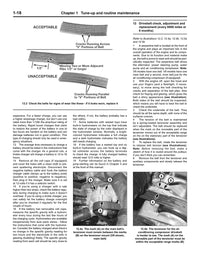Troubleshooting can seem like a mysterious “black art” only practiced by experienced, professional mechanics, when you don't know how certain systems in your car work. Figuring out the problem and solution is simply the result of having the right knowledge combined with an intelligent, systematic approach. If you work by process of elimination, starting with the most likely cause and working through to more complex issues, you can easily diagnose the problem yourself. After that, fixing it is often easy with the help of your Haynes manual.
The newer your car is, the more complicated the electrical system will be, but the charging system is still fairly straight forward to diagnose and fix. Back in the old days, once the motor was running there was little electrical power needed to keep the motor running. High powered sound systems, electric cooling fans, and brighter lighting started putting a strain on alternators back in the 1980s. Modern cars add electronic fuel injection pumps, high voltage ignition systems, electric power steering, and all the computers to control them, so the charging system has to be much more powerful.
Twenty-first century vehicles have integrated the voltage regulator into the Engine Control Module (ECM), or Body Control Module (BCM) computer. Lately, especially in vehicles with fuel saving stop/start technology, the alternator/starter is doing double duty or even triple duty: Charging the battery, running accessories while the engine is off, and restarting the car when you step on the gas. Even without stop/start, the computers now can have six or more charging modes to reduce battery sulfation, increase fuel economy, keep the headlights shining brightly, and other functions.

Before we get into the specifics of the charging system and its problems, you may want to look at some of the basic rules for troubleshooting in general, as presented in the beginning of every Haynes manual: Troubleshooting 101. One of the hardest distinctions to diagnose in the charging system is determining if the battery is starting to go bad, the charging system is under-charging, or there is something draining the battery when the ignition is off. With the motor running, a multimeter on the battery should read 13.5 volts at idle, and go over 14 with any revs, if the alternator is working properly. It should not go over 15 volts.
Much like our earlier posts on troubleshooting clutches, and troubleshooting brakes, there are two basic failure modes in the charging system as well: Either it is working too well and over-charges, or it isn't working well enough and under-charges.
(When troubleshooting electrical issues it is best to start with a battery fully charged with an external charger, and make sure the terminal connections are clean of corrosion and tight)

Undercharging/Not Charging
These days, the charging system not putting out enough power to keep up with the demands of the car is the most common failure. Often times the first indication of a problem is headlights that get noticeably brighter when you step on the gas and rev the motor. Typically the battery icon will light on your dashboard if the charging system power drops below 12 volts.
If the system fails completely for some reason, the battery can provide just enough power to keep everything working properly for at least a handful of miles, but it depends greatly on the vehicle and what electric accessories are running.
Not Charging - revving the engine does not make the lights brighter, or a multimeter shows no increase in voltage output at the battery.
- slipping/missing auxiliary drive belt
- broken connection from alternator to battery
- broken connection from alternator to computer/regulator
- internal short in alternator windings
- mechanical fault
Undercharging - lights dim at idle speed but brighten with revs, or multimeter reads over 13.5 volts when revved
- slipping auxiliary drive belt
- bad connection from alternator to battery
- bad connection from alternator to computer/regulator
- internal short in alternator windings
- bad diode/diodes
For a lack of charge, or an undercharge condition, the first thing to check is a slipping belt. If the belt breaks or is thrown off, it will be obvious and the car will likely be overheating from the water pump not turning. If the belt is there: 1) check (with the engine off) that the spring loaded tensioner is still functioning, or 2) check that the manual adjusting bolts and mounting bolts are tight. If the belt is loose or shiny from slipping, you will need to replace the belt and tensioner, or tighten the adjusters.
The next obvious thing to check is loose or broken electrical connections at the alternator, regulator, and battery. There is typically one thick wire feeding power directly to the battery, plus a plug with several wires connecting to the voltage regulator (if separate), computer, or dashboard warning light/gauge in the instrument cluster. A broken wire will be obvious, but a wire hanging on by a few strands can wreck havoc too, due to increased resistance.
Mechanical faults and internal shorts are hard to see, but often are accompanied by a burned smell. With the engine off, try the alternator pulley to see if there is play from worn bearings. With the belt off, the pulley should spin freely with no grinding or resistance. Remove the alternator and take it to your local auto parts store where they can bench test the output - it only takes a minute and is usually free.
Diodes are a one way valve for electricity, and when working properly convert alternating current (AC) to direct current (DC). A bad diode (there are typically six) lessens the power delivered to the battery, and also introduce AC power into the DC electrical system. AC noise in the system can cause strange things to happen, confusing the computer and other electronics. A bad diode may also allow battery voltage to flow back into the alternator windings, draining the battery while the car is parked. The test station at the local auto parts store will also reveal bad diodes, as will a multimeter set to AC volts - any reading over 0 means a bad diode.
Overcharging
Overcharging is much less of an issue these days, but it does still happen. If your battery appears to have overheated, or is leaking fluid, chances are it has been overcharged, and once the fluid all boils away it won't be able to store electricity any more.
Often times, a battery that is being over charged will give off an acidic smell as the battery acid boils away.
Overcharging - Battery shows signs of heat damage, fluid leaking, or gives off acidic smell.
- bad voltage regulator
- bad connection to regulator/computer
- bad connection to/blown dash warning bulb
As mentioned before, modern cars do their voltage regulation as part of the engine management in the computer. If your 21st-century car is overcharging, the first thing to check for is a bad connection from the battery or alternator to the computer.
Similarly, something as simple as a bad connection to the part of the regulator that senses the voltage of the battery will let the battery over charge.
Lastly, and this may be hard to believe, but the little warning light on the dashboard can sometimes cause an over charge situation. The simplest systems connected through the light bulb, and if it blows out, it can cause the regulator to malfunction. If you are having electrical problems, but the little battery warning light isn't lighting up to warn you. Check that light bulb first.

















